Let's say I have a data frame with several rows like the following:
df <- data.frame(a = c(NA,20,NA),
date1 = c("2016-03-01", "2016-02-01", "2016-02-01"),
b = c(50,NA, NA),
date2 = c("2016-02-01", "2016-03-01", "2016-03-01"),
c = c(10,10, 10),
date3 = c("2016-01-01","2016-01-01", "2016-01-01"))
For each row, I want to get the latest value which is not a NA between a, b, and c according to the dates (so I respectively look at date1, date2, or date3 and pick the most recent one).
Basically, date1 gives the date corresponding to the value a,
date2 gives the date corresponding to the value b,
date3 gives the date corresponding to the value c.
If date1 > date2 & date1 > date3, I will want to take the value a
However, if the value a is NA (which is the case in my example), I will compare date2 and date3. In my example, date2 > date3 , and since value b is not NA but 50, I will take 50 as my final result.
Now I want to do this for all the rows in my dataframe
Since I am using dplyr, I tried to use the case_when function by using the rank function (in my example, I look a the first ranked date, and then look at the linked value. If it is a NA, I look at the 2nd best ranked, etc...)
However, I can't just put, as I'd like to do, :
df <- df %>%
mutate(result = case_when(is.na(a) & is.na(b) & is.na(c) ~ NA_integer_,
rev(rank(date1, date2, date3))[1] == 3 & !is.na(a) ~ a,
rev(rank(date1, date2, date3))[2] == 3 & !is.na(b) ~ b,
rev(rank(date1, date2, date3))[3] == 3 & !is.na(a) ~ c,
rev(rank(date1, date2, date3))[1] == 2 & !is.na(a) ~ a,
rev(rank(date1, date2, date3))[2] == 2 & !is.na(b) ~ b,
rev(rank(date1, date2, date3))[3] == 2 & !is.na(a) ~ c,
rev(rank(date1, date2, date3))[1] == 1 & !is.na(a) ~ a,
rev(rank(date1, date2, date3))[2] == 1 & !is.na(b) ~ b,
rev(rank(date1, date2, date3))[3] == 1 & !is.na(a) ~ c))
Because the rank function needs a unique vector as argument (but I can't put c(date1, date2, date3) neither because it would give me the whole order of this vector and not the rank for each row)
In my example the result I would like to have would be
res
a date1 b date2 c date3 result
NA 2016-03-01 50 2016-02-01 10 2016-01-01 50
20 2016-02-01 NA 2016-03-01 10 2016-01-01 20
NA 2016-02-01 NA 2016-03-01 10 2016-01-01 10
Does anyone have an idea or even an entirely different approach to this problem ?

